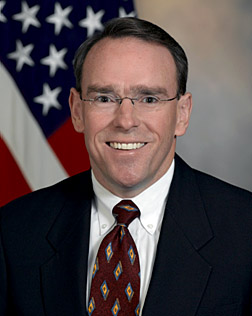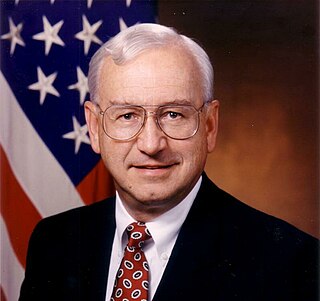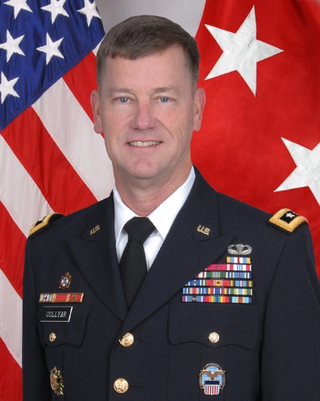
Redstone Arsenal is a United States Army base adjacent to Huntsville,Alabama in the Wheeler National Wildlife Refuge. A census-designated place in Madison County,Alabama,United States,it is part of the Huntsville-Decatur Combined Statistical Area. The Arsenal is a host to over 75 tenant agencies including the Department of Defense (DoD),Department of Justice (DOJ),the Federal Bureau of Investigation (FBI),and NASA's largest field center,the Marshall Space Flight Center.

The MGM-140 Army Tactical Missile System is a supersonic tactical ballistic missile designed and manufactured by the US defense company Ling-Temco-Vought (LTV),and later Lockheed Martin through acquisitions.

Ashton Baldwin Carter was an American government official and academic who served as the 25th United States secretary of defense from February 2015 to January 2017. He later served as director of the Belfer Center for Science &International Affairs at Harvard Kennedy School.

The United States Army Aviation and Missile Command (AMCOM) develops,acquires,fields and sustains aviation,missile and unmanned aerial vehicles. AMCOM is primarily responsible for lifecycle management of army missile,helicopter,unmanned ground vehicle and unmanned aerial vehicle weapon system. The central part of AMCOM's mission involves ensuring readiness through acquisition and sustainment support for aviation systems,missile systems,and test,measurement,and diagnostic equipment (TMDE) throughout their life cycle. The command is headquartered at Redstone Arsenal in Huntsville,Alabama,has a 2019 "budget of more $3.7 billion,and a global workforce of more than 15,000 military and civilian employees".

The Air Force Systems Command (AFSC) is an inactive United States Air Force Major Command. It was established in April 1951,being split off from Air Materiel Command. The mission of AFSC was Research and Development for new weapons systems.
A program executive officer,or PEO,is one of a few key individuals in the United States military acquisition process. As can be seen from the examples below,a program executive officer may be responsible for a specific program,or for an entire portfolio of similar programs.

Lieutenant General Larry James Dodgen was Commander,U.S. Army Space and Missile Defense Command.

The Office of the United States Assistant Secretary of the Army for Acquisition,Logistics,and Technology (ASA(ALT) pronounced A-salt) is known as OASA(ALT). OASA(ALT) serves,when delegated,as the Army Acquisition Executive,the Senior Procurement Executive,the Science Advisor to the Secretary of the Army,and as the senior research and development official for the Department of the Army. The OASA(ALT) also has the principal responsibility for all Department of the Army matters related to logistics.

Amanda Renae Simpson is an American pilot,businessperson and politician.

John Jacob Young Jr. was United States Assistant Secretary of the Navy from 2001 to 2005 and Under Secretary of Defense for Acquisition,Technology and Logistics from 2007 to 2009. He is the founder and principal of JY Strategies,LLC.

Claude Milburn Bolton Jr. was a United States Air Force major general who served also as United States Assistant Secretary of the Army for Acquisition,Logistics,and Technology from 2002 to 2008.

Lieutenant General (Ret.) August Schomburg was the Commander of the United States Army Ballistic Missile Command,and later Commandant of the Industrial College of the Armed Forces. He retired from Active Duty military service in 1967,and died in 1972. He is buried at Arlington National Cemetery. His wife Fern Wynne Schomburg died in 1996.

Paul Garrett Kaminski is a technologist and former U.S. government official,best known for his leading role in the development of stealth aircraft.

The U.S. Army Acquisition Support Center (USAASC) is part of the Office of the Assistant Secretary of the Army for Acquisition,Logistics,and Technology. USAASC is headquartered at Fort Belvoir,Va.
William Ames Davis Jr. was an engineer and distinguished leader in Ballistic Missile Defense (BMD) for the United States Army at Redstone Arsenal in Huntsville,Alabama. Davis was an inaugural member of the United States Senior Executive Service (SES) and recipient of numerous accolades and awards from the army,including the Meritorious Civilian Service Award (1980) and the Department of the Army Decoration for Exceptional Civilian Service (1982).

Major General James William Ball was a career officer in the United States Army who served as the 24th Chief of Ordnance for the United States Army Ordnance Corps.

Major General Lynn A. Collyar is a retired general officer in the United States Army and served as the Commanding General,U.S. Army Aviation &Missile Command between from 2012 to 2014. Prior to this assignment,he served as the 35th Chief of Ordnance and Commandant of the U.S. Army Ordnance School at Aberdeen Proving Ground,Maryland and Fort Lee,Virginia.

Major General Robert David Shadley is a retired general officer in the United States Army and served as the Director of Logistics,G-4,for the United States Army Forces Command at Fort McPherson,Georgia. Prior to this assignment,he served as the 28th Chief of Ordnance and Commandant of the U.S. Army Ordnance School at Aberdeen Proving Grounds,Maryland.

Rutledge Parker "Hap" Hazzard was director of Science and Technology division of Central Intelligence Agency (CIA) from 1973 to 1978. He became director of the National Photographic Interpretation Center (NPIC) in 1978. After serving six years as director of NPIC from June 1978 to February 1984,Hazzard returned to the CIA's National Intelligence Office. He retired from public service in 1985.

Juanita M. Christensen is an American government official and electronics engineer. She is the deputy chief of staff for logistics (G4) of facilities and environmental at the United States Army Materiel Command. From November 2017 until January 2021,Christensen was director of the United States Army Aviation and Missile Center. In February 2015,she became the first African-American woman from Redstone Arsenal to join the Senior Executive Service.

















